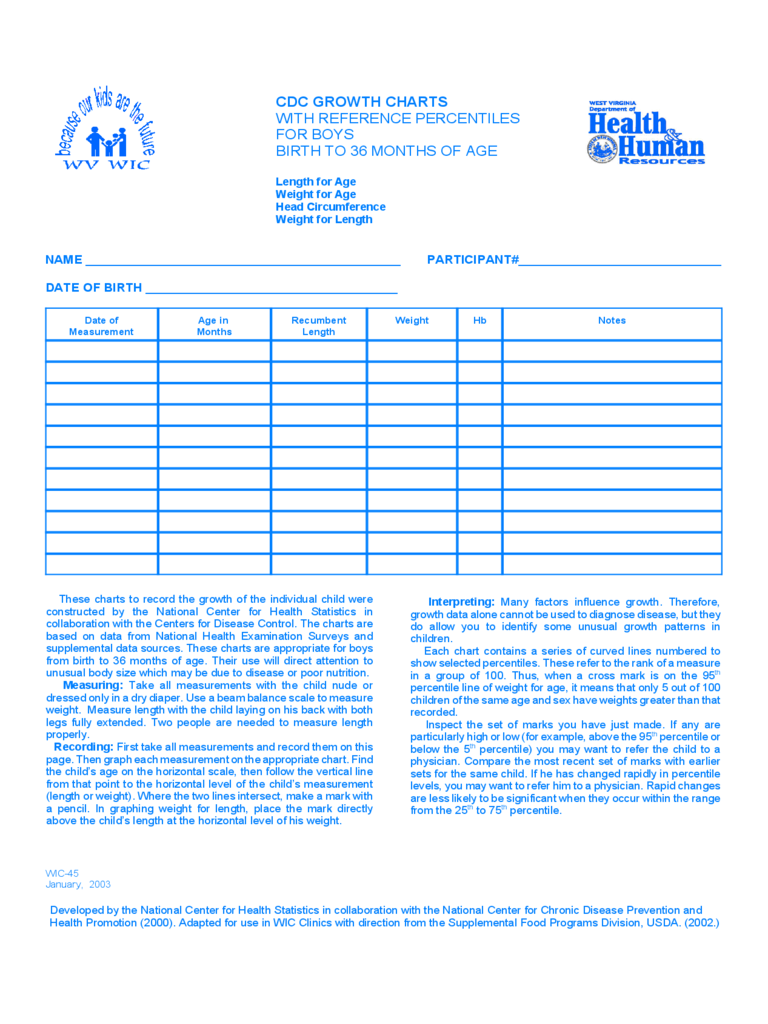Fillable Printable CDC Growth Chart Sample
Fillable Printable CDC Growth Chart Sample

CDC Growth Chart Sample

NAME _____________________________________________ PARTICIPANT#_____________________________
DATE OF BIRTH ____________________________________
Date of
Measurement
Age in
Months
Recumbent
Length
Weight Hb Notes
WIC-45
January, 2003
These charts to record the growth of the individual child were
constructed by the National Center for Health Statistics in
collaboration with the Centers for Disease Control. The charts are
based on data from National Health Examination Surveys and
supplemental data sources. These charts are appropriate for boys
from birth to 36 months of age. Their use will direct attention to
unusual body size which may be due to disease or poor nutrition.
Measuring: Take all measurements with the child nude or
dressed only in a dry diaper. Use a beam balance scale to measure
weight. Measure length with the child laying on his back with both
legs fully extended. Two people are needed to measure length
properly.
Recording: First take all measurements and record them on this
page. Then graph each measurement on the appropriate chart. Find
the child’s age on the horizontal scale, then follow the vertical line
from that point to the horizontal level of the child’s measurement
(length or weight). Where the two lines intersect, make a mark with
a pencil. In graphing weight for length, place the mark directly
above the child’s length at the horizontal level of his weight.
Interpreting: Many factors influence growth. Therefore,
growth data alone cannot be used to diagnose disease, but they
do allow you to identify some unusual growth patterns in
children.
Each chart contains a series of curved lines numbered to
show selected percentiles. These refer to the rank of a measure
in a group of 100. Thus, when a cross mark is on the 95
th
percentile line of weight for age, it means that only 5 out of 100
children of the same age and sex have weights greater than that
recorded.
Inspect the set of marks you have just made. If any are
particularly high or low (for example, above the 95
th
percentile or
below the 5
th
percentile) you may want to refer the child to a
physician. Compare the most recent set of marks with earlier
sets for the same child. If he has changed rapidly in percentile
levels, you may want to refer him to a physician. Rapid changes
are less likely to be significant when they occur within the range
from the 25
th
to 75
th
percentile.
Developed by the National Center for Health Statistics in collaboration with the National Center for Chronic Disease Prevention and
Health Promotion (2000). Adapted for use in WIC Clinics with direction from the Supplemental Food Programs Division, USDA. (2002.)
CDC GROWTH CHARTS
WITH REFERENCE PERCENTILES
FOR BOYS
BIRTH TO 36 MONTHS OF AGE
Length for Age
Weight for Age
Head Circumference
Weight for Length

Available at http://www.nal.usda.gov/wicworks
SOURCE: Developed by the National Center for Health Statistics in collaboration with
the National Center for Chronic Disease Prevention and Health Promotion (2002).
http://www.cdc.gov/growthcharts
WIC Makes A Difference

WIC Makes A Difference
Available at http://www.nal.usda.gov/wicworks
SOURCE: Developed by the National Center for Health Statistics in collaboration with
the National Center for Chronic Disease Prevention and Health Promotion (2002).
http://www.cdc.gov/growthcharts

Date Worker Notes*
*This form does not take the place of STORC entries. All information that is required to be entered in STORC
must
be recorded within the STORC data system as well.



